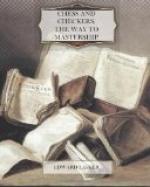While in the early Middle Ages the game was played in Europe with the same rules as in the Orient, some innovations were introduced by the European players in the later Middle Ages which proved to be so great an improvement that within a hundred years they were generally adopted in all countries including the Orient. The reason for the changes was that in the old form of the game it took too long to get through the opening period. The new form, which dates from about 1500 A.D. and the characteristic feature of which is the enlarged power of Queen and Bishop, is our modern Chess, the rules of which are uniform throughout the civilized world.
In the Seventeenth Century Chess flourished mostly in Italy, which consequently produced the strongest players. Some of them traveled throughout Europe, challenging the best players of the other countries and for the most part emerging victorious. At that time Chess was in high esteem, especially at the courts of the kings who followed the example of Philip the Second of Spain in honoring the traveling masters and rewarding them liberally for their exhibition matches.
Towards the beginning of the Eighteenth Century the game reached a high stage of development in France, England and Germany. The most famous master of the time was the Frenchman, Andre Philidor, who for more than forty years easily maintained his supremacy over all players with whom he came in contact, and whose fame has since been equaled only by the American Champion, Paul Morphy, and by the German, Emanuel Lasker.
During the Eighteenth and Nineteenth Centuries the number of players who obtained international fame increased rapidly, and in 1851, due to the efforts of the English Champion Staunton, an international tournament was held in London to determine the championship of Europe. It was won by the German master Anderssen, who maintained his leading place for the following fifteen years, until he was beaten by the youthful Morphy. The latter, at twenty years of age, was the first American master to visit Europe and defeated in brilliant style all European masters whom he met.
Morphy withdrew from the game after his return to America and did not try to match himself with the Bohemian Steinitz, who in the meantime had beaten Anderssen, too, and who had come to America. Steinitz assumed the title of the World’s Champion and defended it successfully against all competitors until 1894, when he was beaten by Emanuel Lasker, who is still World’s Champion, having never lost a match.
The next aspirant for the World’s Championship is the young Cuban, Jose Raoul Capablanca, who has proved to be superior to all masters except Lasker. He entered the arena of international tournaments at the age of twenty-two in San Sebastian, Spain, in 1911, and won the first prize in spite of the competition of nearly all of Europe’s masters. In the last international tournament, which was held in Petrograd in 1914, he finished second, Emanuel Lasker winning first prize.




